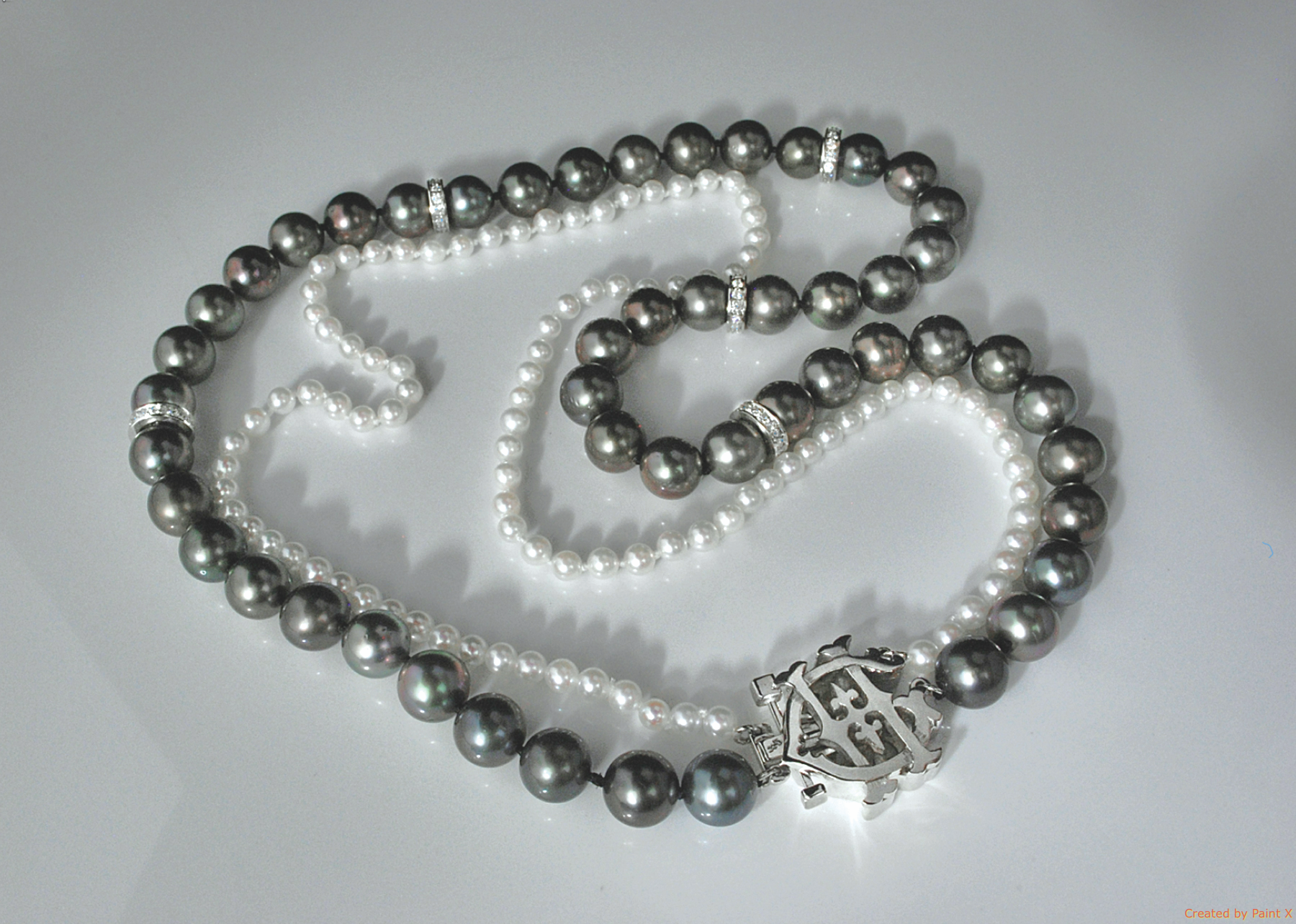Crafting a Custom Pearl Necklace
3 Minute Read
"Your mission, should you choose to accept it…" I often recall those words from "Mission Impossible" as I approach a design project. The pearl necklace "mission" shown here presented some interesting and subtle challenges.
The following are the client's specifications for this understated but highly symbolic piece of jewelry, a surprise anniversary gift for his wife. This necklace must consist of:
- Exactly 50 large black Tahitian pearls
- Exactly 100 white Japanese pearls
- A clasp design that is not only functional but displays a historical motif with special meaning to the commissioner's family (Scottish origin) incorporating the letters G and H
- Five diamond sections containing exactly 1 carat total weight of diamonds
Crafting a Custom Pearl Necklace
With all custom design projects, I begin by producing a technically correct rendering to scale. This allows me to mentally work through the project, discovering the details involved and making a plan for construction. I began with 50 9.5 mm diameter black Tahitian pearls and drew the 21-inch outer strand, which would include five diamond-set 14k white gold spacers.
Next, I moved on to the inner strand of 100 4.8 mm white pearls, which are approximately half the size of the black pearls. This is where it becomes clear that the devil is in the details. If I were to knot each pearl, the black pearl strand would have 51 knots and the white pearl strand would have 101 knots. This would obviously cause the two strands to terminate at different lengths, which would be a fatal design flaw.
To solve the problem, I strung the black pearls first, allotting one knot length for each of the five spacers, and measured. Based on this measurement, I made two test strands of 100 white 4.8 mm pearls: one with knots, the other without. To figure out the average space of each knot, I measured the length of 10 pearls without knots, then 10 pearls with knots, and divided the difference by 10. These calculations showed that 66 knots would enable the strand to terminate at the same point as the black pearl strand. I would simply vary the knot placement on the strand as needed.
Designing the clasp was another fun challenge. Searching though my library of engravings, I found the G and H monogram. The artist is H. Renoir of Edinburgh, Scotland, circa 1870. What could be more perfect, given the family's Scottish origin?
I hand carved the clasp parts in wax. Notice how the top plate is slightly curved. This will cause the finished piece to dome slightly forward to the eye. This yields a softer, more feminine effect, as opposed to a flat surface, which produces a more masculine, blocky effect.
I decided to make the angle of union for the male and female clasp components 75 degrees, not 90 degrees. This will allow the finished clasp to "curve" into the two strands, creating a graceful flow and fit to the entire necklace.
This image shows the seven 14k white castings that are used in the piece. The item on the left is the housing and back plate for the clasp, which I hand drew, hand carved in wax, and cast. For the five round spacers, I carved a model in wax, cast it in silver, and then rubber molded the pieces. The rubber mold allowed me to cast five copies of the original master. Each would be set with 0.2 total carat weight of diamonds, resulting in a total of 1 carat of diamonds in the necklace. Notice how each spacer is deeply domed inward on each side. This ensures that it occupies no more than a single knot of space along the strand.
The owner surprised his wife with the finished necklace at their 50th anniversary party.
The award-winning Journal is published monthly by MJSA, the trade association for professional jewelry makers, designers, and related suppliers. It offers design ideas, fabrication and production techniques, bench tips, business and marketing insights, and trend and technology updates—the information crucial for business success. “More than other publications, MJSA Journal is oriented toward people like me: those trying to earn a living by designing and making jewelry,” says Jim Binnion of James Binnion Metal Arts.
Click here to read our latest articles
Click here to get a FREE four-month trial subscription.
You assume all responsibility and risk for the use of the safety resources available on or through this web page. The International Gem Society LLC does not assume any liability for the materials, information and opinions provided on, or available through, this web page. No advice or information provided by this website shall create any warranty. Reliance on such advice, information or the content of this web page is solely at your own risk, including without limitation any safety guidelines, resources or precautions, or any other information related to safety that may be available on or through this web page. The International Gem Society LLC disclaims any liability for injury, death or damages resulting from the use thereof.
The All-In-One Jewelry Making Solution At Your Fingertips
When you join the Ganoksin community, you get the tools you need to take your work to the next level.
Trusted Jewelry Making Information & Techniques
Sign up to receive the latest articles, techniques, and inspirations with our free newsletter.
